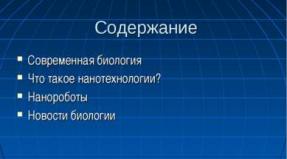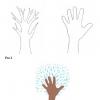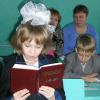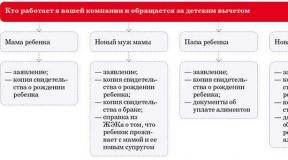Garegin II Catholicos of all Armenians. Garegin II: biography. Letter to the editor
Today Garegin II celebrates his 65th birthday. And remembering the history of the reign of this church father, you understand how precisely it was said: “If you want to hurt a priest, hit him in the pocket.” This wise advice from the Irish classic Jonathan Swift, unfortunately (for me as a Christian and as an Armenian), can be successfully used in relation to the majority of clergy of the Armenian Church. Over the past 20 years, the Armenian Catholic Church has continually become the epicenter of a wide variety of incidents and scandals. Everything happens: the funny - for example, priests beating each other right on the porch, who could not share a rich client-godson, and the terrible - the rape of a girl right in the Goris church, sexual violence against students in the Etchmiadzin seminary. Well, tens of millions of dollars of Armenian bishops, archimandrites and other hierarchs stored offshore are generally in the order of things.
The mafia of the Armenian church includes grandmothers who sell candles in front of churches and thus earn their penny for retirement, and Catholicos Garegin II himself with his millions in HSBC - the largest bank in the world, and connections with crime bosses, thieves in law, etc.
In Armenia they still remember the story of how Karekin II ascended the Holy Throne and became the 132nd Armenian Catholicos. Then, back in 1999, shortly before his death in the sensational parliamentary massacre, the Prime Minister of the Republic Vazgen Sargsyan personally and without skimping on his means forced all the bishops to vote for Karegin. Rumor has it that Garegin haggled with Vazgen for a long time until they agreed on twenty million dollars. As fate would have it, precisely at the time when the ceremonial elections and inauguration of the Catholicos were taking place in Etchmiadzin, the shooting of the parliament took place in Yerevan, during which Karegin’s patron, Sargsyan, was also killed. But the lot of the intimidated hierarchs had already fallen on Garegin and he ascended the throne.
From the first years of his primacy, Karekin II began to carry out large-scale “reforms” with the goal of turning the temple of God into his personal fiefdom, where the biblical canons were mercilessly supplanted by the orders he himself established. All the efforts of the current Catholicos come down to one thing - under the auspices of the church, to pump out money from wherever possible.
The most valuable church utensils stored there for centuries began to disappear from the famous “Treasury of Etchmiadzin” museum; luxury restaurants, entertainment complexes and even casinos and nightclubs were built on lands owned by the church. The Etchmiadzin elite, that is, Garegin’s retinue, consisting mainly of bishops and archimandrites, engaged in activities so far from the purpose of the church, such as delivery from abroad and sale of expensive foreign cars, construction business, production of hygiene products, fishing (nothing to do with fishing biblical apostles, this is, of course, not a profitable business) and much more.
But the main source of income for Garegin and his associates was, of course, donations, mainly from wealthy foreign benefactors. Several times a year they, the Etchmiadzin hierarchs, began to organize peculiar “crusades” against the Armenian diaspora, collecting tens of millions of dollars “in the name of the Church.”
The state authorities, which turn a blind eye to all these sacrileges, are not left to lose either: using church funds, Garegin launders millions of dollars for his fellow members of the country’s ruling elite.

At times, however, the machinations of clergy become public. Thus, in 2013, thanks to a journalistic investigation, it turned out that the owners of the Cyprus offshore company “Wlisperaholdingslimited” are the then Prime Minister of Armenia, and now the Ambassador of Armenia to the United States, Tigran Sargsyan and the head of the Ararat diocese of the Armenian Apostolic Church, Archbishop Navasard Kchoyan. A scandal broke out, but it didn’t end in anything; no one was punished. Archbishop Kchoyan then simply said: “It’s not me,” and they... believed him, but for some reason no one was interested in the fact that his name was in the published documents of this company. And those who were especially meticulous, intent on getting to the bottom of the millions of the Archbishop, who was traversing the space in Yerevan in a brand new Bentley, were quickly beaten off this hunt, and I even know how.
At the request of my friend, who then in 2012 served as a deacon in one of the churches in the Syunik marz (district), I published material about what abomination the archimandrites committed in Goris, essentially turning the temple into a brothel. And what? An article about this in a couple of hours was removed from all blogs and media outlets that risked publishing it, and the next day I received a call from, as it later turned out, the main defender of the Syunik clerics - the head of the customs service of Sisian, and part-time criminal authority Ashot Minasyan. The eminent customs officer even took the trouble to come to Yerevan in person to persuade me to give the name of my informant. Having not received the expected result, Minasyan tried to put pressure on me with the help of my friends in the opposition. In this case, the result was, but not at all what he expected: a mini-lustration occurred, revealing that many Armenian ardent oppositionists and civil activists were in fact ordinary messengers of a simple customs chief. So it is not difficult to guess what kind of pressure the media were subjected to when they published materials about the owners of the Cypriot offshore company.

Meanwhile, scandals surrounding the “commercial” activities of the Armenian church under the chairmanship of Karekin II gradually began to spread beyond the borders of Armenia. One can talk and write endlessly about spiritual fathers who became famous abroad - here is the Armenian Church of St. Nazareth in Calcutta, where in order to build a parking lot and a cafe, its ministers decided to demolish part of the historical cemetery adjacent to the temple. And only the Institute of Archaeological Research of India considered this an act of vandalism and a crime, and the Times of India newspaper found out that the mentioned decision was made after the visit of the Catholicos of All Armenians Karekin II to Calcutta, that is, most likely, everything happened with his approval. Or, let’s say, how can one not recall an article in the French publication “Nice-Matin”, published in 2011, where one of the close associates of the Catholicos, the archimandrite of the Armenian Church in France Vache Hayrapetyan. More recently, this summer, there have been a number of incidents involving Armenian churches in Belgium and the Netherlands.
However, let's return to Armenia. During his years at the helm of the Armenian Catholic Church, Karekin II did everything to ensure that the Armenian clergy became an integral part of the country's government. Most Armenians have long associated clergy with a certain caste that serves not so much God as the regime of Serzh Sargsyan. The President, it should be noted, greatly values this service. How could it be otherwise, if it is thanks to Echmiadzin that the oligarchs who are part of the backbone of his regime, under the guise of charity, can freely launder tens and hundreds of millions of dollars.
The church also plays a significant role in the internal political processes in the country, acting both openly and playing its own behind-the-scenes game. Openly, these are, for example, the fiery speeches of Karekin II, in which he elevates, almost to the rank of saints, certain representatives of the ruling elite who need to raise their ratings. Or, say, the presence and participation of clergy in all popular protests, which has already become mandatory: at the most tense moments among the demonstrators, holy fathers suddenly appear out of nowhere and begin to rant about “peace” and “our brothers in police uniforms.” The church enters into behind-the-scenes intrigues mainly during the pre-election period, when, using the levers it has, it secures the coveted percentages for Sargsyan’s candidates.
Those few of its ministers who, God forbid, dare to express even a hint of oppositional sentiments, are mercilessly punished by the church, first expelled “in disgrace” from its ranks, and then in every possible way denigrating in the press those who dared to encroach on the holy of holies - the regime (! ). This recently happened to the spiritual mentor of the Armenian community in the Netherlands, Aram Melkonyan, who took part in a picket organized by the Armenian community in Amsterdam demanding the release of political prisoners in Armenia. Almost immediately, within an hour, by order of the Catholicos, Father Aram was deprived of his rank and rank as a mentor of the Dutch community. Moreover, Etchmiadzin expressed its official opinion, angrily condemning Melkonyan’s “daring act.” The message, in particular, said: “We are deeply hurt and annoyed when we see such behavior of a clergyman, which in no way can express the position of the Armenian Apostolic Church.”
From all this we can conclude that the Armenian Apostolic Church welcomes political repressions and arrests for political reasons. It must be said that then Father Aram was not at all taken aback and published his worthy and courageous response to Karekin the Second.
“I, too, am deeply hurt and annoyed when I see how the church and spiritual fathers have become indifferent and indifferent to the problems of the Armenian people. Each of you, as if hiding, is waiting for the moment when someone else’s scales tip the scales, so that at that very hour you can rally around this person. I am sure that if the Sasna Tsrer (rebels) had emerged victorious (which is not yet ruled out), you would have given my actions a completely different assessment.”
However, there are only a few people like the demoted priest Melkonyan, and the church, in order to eliminate all possible risks with its clergy, tries to keep the obstinate at a distance - in the Netherlands, the USA, Libya, etc. Garegin the Second understands that in Armenia such misfires can be expensive he could do without it, and therefore surrounded himself and Sargsyan with the most obedient and reliable “presbyters.”
It is impossible not to say at least a few words about one of these “reliable” people, whom Sargsyan especially brought close to his person. This character, worthy of competing with the eminence grise Richelieu himself, and in some nuances even with the legendary Pope Alexander the Sixth (Rodrigo Borgia), is Archimandrite Mesrop Aramyan, who is also an adviser to the President of Armenia.

Let’s leave Aramyan’s activities aside for now until his appointment as presidential adviser in 2013, although a lot of interesting things can be found there, for example, combining church duties and... production activities (!) (the rumor about his “castings” of young girls would be the envy of Caligula himself) . Having taken the post of presidential adviser, the archimandrite immediately established himself as an indispensable servant of the regime. In parallel with bringing to perfection the scheme for laundering huge financial resources through the Luys charitable foundation managed by him (founded, by the way, in 2009 by Serzh Sargsyan and then Prime Minister Tigran Sargsyan), he undertook to supervise, of course, unofficially, several “opposition » Media (“ArmenPress”, “Yerkir Media”, 1in.am, lurer.com, etc.). Thanks to his phenomenal ability to weave intrigues using these publications, Aramyan contributed his lion's share to the formation of Sargsyan's favorite brainchild - the “controlled opposition.”

Well, I think it will be interesting to get acquainted with some official figures regarding the personal funds of Archimandrite Mesrop Aramyan, taken from the reports of the Commission on Ethics of High-Ranking Officials of Armenia.
Officially, Aramyan first declared his income and property in 2013, and even then he had 64 million 843 thousand drams, 41 thousand US dollars, a 4-room apartment in an elite building in the center of Yerevan, a mansion in an elite area of Yerevan, a number of industrial buildings, car brand Toyota Land Cruiser 150 4.0. And it is unclear where the income of Aramyan’s wife (officially unemployed) came from in the same 2013 amounted to 45 thousand US dollars and 3 million drams.
In 2014, the holy father’s fortune increased significantly, and he purchased another mansion for 200 thousand dollars. The declared income remained almost unchanged - the same 61 million drams. In 2015, Aramyan reported 55 million drams, and his wife reported income (!) of 60 thousand dollars.
Let me remind you that Father Mesrop officially works as an adviser to the President of the Republic of Armenia on a voluntary basis.
To the 60th anniversary of the birth of the Supreme Patriarch and Catholicos of All Armenians
Ararat Valley. The village of Voskehat near Holy Etchmiadzin. There, in the simple peasant family of Grigor Nersisyan and Khatun Mikaelyan, on August 21, 1951, a son was finally born. They named him Ktrich, which translated from Armenian means daredevil, brave, fearless. By the will of above, he was destined to become the Supreme Shepherd of the nation.
LARGE FAMILY HOME
Ktrich Nersisyan received his primary education at the school of his native village. At the age of 20, he graduated from the Gevorgyan Theological Seminary of the Mother See of Holy Etchmiadzin with honors (in the penultimate year of his studies he was ordained a deacon) and already as an assistant inspector taught the Holy Scriptures of the New Testament within the walls of the same seminary.
Garegin II:
“I was born and raised in a God-loving family. Under my father's roof hovered a spirit of prayer, faith, devotion and fidelity to the Church, and a zealous desire for national values. Accompanied by my parents, I crossed the threshold of the Cathedral of Holy Etchmiadzin, not without excitement, attending services and Divine Liturgies on Sundays and holidays. Step by step, this vigil brought me closer to God, cultivating in my soul a feeling of special affection for the Church, having a beneficial influence both on my whole life and on my firm choice - to devote myself to serving our people in the bosom of the Holy Apostolic Church.” (Hereinafter in the text fragments from speeches, interviews and kontakia of Garegin II are used).
God gave Grigor and Khatun six children. The eldest daughter was named Bavakan, putting into this name the wish for full-blooded joys of life. Next, Tsagik was born, the scarlet flower of their expectations. Ktrich came third. Mariam and Gevorg increased their parental goodness. And with cries of indescribable delight they greeted the appearance of the youngest in the family - Mkrtich: in honor of John the Baptist. He, the current Patriarchal Exarch, head of the New Nakhichevan and Russian Diocese of the Armenian Apostolic Church (AAC), Bishop Ezras Nersisyan, also dedicated himself to the Lord.

The father worked on a collective farm, later on a state farm, the mother ran the household, and together they raised all six of them and put them on their feet. The head of the family managed to earn daily wages and take care of his personal plot and vegetable garden. The vineyard and orchard helped out, so there was no shortage of fresh fruits and berries in the house all year. There were also a cow, sheep, chickens and a dozen beehives.
I once asked Bishop Yezras how the family got to Sunday services in Holy Etchmiadzin, since from the village to Holy Etchmiadzin it would be three kilometers. And I heard in response: “When I hitch a ride, but more often on foot. And in any weather. And we were never late for the morning liturgy. Sundays were sacred for my father. On these days, he didn’t even pick up a spade in the morning.”
A front-line soldier, disabled person of Group II of the Great Patriotic War, Grigor Nersisyan managed to fight in Karabakh. His daughter Tsagik also fought there, leaving her husband to look after the children, of whom there were four.
Grigor Nersisyan passed away on October 27, 2009, at the age of 88, on the tenth anniversary of the announcement of his son as Catholicos of All Armenians.
COURAGE OF THE SPIRIT
In 1972, Deacon Ktrich Nersisyan, elevated to the rank of hieromonk by Archbishop Tiran Nersoyan and named Garegin, at the behest of Catholicos of All Armenians Vazgen I, was sent to the capital of Austria to continue his studies at the Faculty of Theology of the University of Vienna. Three years later, he was already serving as a spiritual shepherd in the German diocese of the Apostolic Church, while continuing to study theology at the University of Bonn. Returning to Holy Etchmiadzin in 1979, at the insistence of Vazgen I, he went to the Trinity-Sergius Lavra in Zagorsk (now Sergiev Posad) - to graduate school at the Moscow Theological Academy of the Russian Orthodox Church (ROC).

Garegin II:
“I remember studying in Russia with love, and this feeling accompanies me to this day. It is gratifying that even now the doors of the Moscow Theological Academy are open to Armenian seminarians. This allows us to better know and understand the spiritual life of Russia.”
In March 1980, Garegin Nersisyan was already an assistant vicar, and since June 1983 - vicar of the Ararat Patriarchal Diocese. Ordained as a bishop on October 23 of the same year, he was appointed primate of the same diocese. It was he who founded the Sevan Theological Seminary in his diocese in 1990, named in memory of Vazgen I - Vazgenyan. Its students, having completed a five-year course of education, undergo a year-long internship at the Gevorgyan Theological Seminary. Through the efforts of Garegin Nersisyan, under the patronage of the AAC, the Center for Christian Education was created, which covered 56 secondary schools in Yerevan. Two years later, the primate of the Ararat diocese was introduced to the Supreme Spiritual Council. Through the efforts of Garegin Nersisyan, in 1992, three former Palaces of Pioneers in the Armenian capital were transformed into Houses of Children and Youth Education, where thousands of children still receive spiritual and aesthetic education. In November of the same year, Bishop Garegin Nersisyan was elevated to the rank of archbishop.
In 1995, after the death of Catholicos of All Armenians Vazgen I, elections for the Supreme Patriarch were held. Having every chance of victory, Archbishop Garegin Nersisyan at the third stage of the elections withdraws his candidacy in favor of Catholicos of the Great House of Cilicia Garekin II Sarkissian, who ascended to the throne of Holy Etchmiadzin as Catholicos of All Armenians Karekin I.
For the sake of saving the nation, Garegin Nersisyan, a man of high civic courage, wanting to put an end to the discord in the Armenian Church provoked by Soviet power, consciously took such a wise step in the name of merging the two branches of his native Church.
On November 30, 1998, by the kontakion of Karekin I, Archbishop Garegin Nersisyan was appointed chief vicar of the Catholicos of All Armenians. Alas, in June 1999, Garegin I was called to himself by the Lord.

ELECTION OF PATRIARCH
October 27, 1999. This day is inscribed in the modern history of Armenia by two events - the election of the Catholicos of All Armenians and an unprecedented terrorist attack in the National Assembly of Armenia. Speaker of Parliament Karen Demirchyan and Prime Minister of the Republic Vazgen Sargsyan, among many, fell at the hands of lawless people.
On that sad day, the National Church Council, the highest governing body of the AAC, notified the Armenians that they now had a new Supreme Patriarch - Catholicos of All Armenians Garekin II Nersisyan.
Garegin II:
“At the moment when I was paying tribute in church to everyone who had placed their trust in me, I was informed about a terrible crime - an execution in the country’s parliament. It shocked me. I ascended the Patriarchal throne with tears in my eyes and pain in my heart.”
From now on, Karekin II, His Holiness the Supreme Patriarch and Catholicos of All Armenians, elected to this position for life, represents the highest central ecclesiastical authority of the Armenian Apostolic Church, supervises all church institutions, is the guardian of dogmatic teaching and the supreme judge.
In official documents, such as kontakia, decrees-messages of the Catholicos of All Armenians, the full title of the Head of the Armenian Apostolic Church reads as follows: “Garegin II Servant of Jesus Christ, by the grace of God and the will of the people, High Hierarch and Catholicos of All Armenians, Supreme Patriarch of the nationally venerable Ararat Throne of the Apostolic Church of the Mother See Holy Cathedral Etchmiadzin."
Among the insignia of the Catholicos of All Armenians, in addition to the title, there is also a coat of arms, a seal, a veil with the image of a Lamb, a banner, a large and small staff, a club, a throne, tents (an honorary retinue in red robes with maces in their hands), strewn with diamonds cross on the hood.
Among the primary tasks, the Catholicos saw the streamlining of the internal life of the Church, the revitalization of the work of religious educational institutions, the intensification of Christian preaching, the restoration and restoration of ancient monasteries and churches, including those lost in the mountains.
And Garekin II began by founding the Theological Armenological Center named after Garekin I in the Treasury of “Alek and Marie Manukyan” in Holy Etchmiadzin to cultivate new generations of clergy, ordering to open access to the rich library of the center and wide layers of the intelligentsia.

He also took the Gevorgyan Theological Seminary, which had gained fame throughout the world, under his special care.
Garegin II:
“The educational program at our seminary covers six years, after which graduates go for one or two years to higher spiritual educational institutions - academies. We believe that only after eight years of training is a priest ready for ministry.”
And the introduction of Garegin II into charitable deeds began.
The Christian world was faced with a dilemma: where and how to celebrate the 2000th anniversary of the birth of the baby Jesus. It was agreed that it would be most appropriate to visit Jerusalem, and the top officials of Western states went to the Holy Land on December 25, 1999. Patriarch of Moscow and All Rus' Alexy II and the President of Russia arrived there on January 7, 2000.
As for the Supreme Patriarch of Armenians
Garegin II, then on the night of January 19, 2000, on the day of Epiphany, His Holiness celebrated the Divine Liturgy in the Grotto of the Holy Nativity of Christ. It was here that our Catholicos voiced his Christmas covenant, ending it with the words: “How comforting it is to believe that God is with us!” Armenian President Robert Kocharyan honored the ceremony with his presence.
On August 28-31, Garegin II traveled to New York. At the UN headquarters, at the World Summit of Religious and Spiritual Leaders, he delivered a meaningful report - “Towards forgiveness and reconciliation.”
In September, Holy Etchmiadzin and the Ministry of the Armed Forces of Armenia developed basic provisions on the spiritual service of priests in the army.
On November 11, in the Vatican, Pope John Paul II and Karekin II sign a communiqué. In it, the policy of the Turkish state at the beginning of the 20th century towards the Armenian population is defined as genocide. The very fact of recognition of the Armenian genocide by the Vatican should be honored as a success of the humanitarian mission of the Armenian Patriarch.
On that significant day, the Pontiff presented the Catholicos of All Armenians with part of the relics of St. Grigor Lusavorich, the High Priest of the Armenians Gregory the Illuminator.
December 18, 2000. Khor Virap Monastery under the biblical Mount Ararat. Twelve monks of the Mother See of Surb Echmiadzin descend into the underground dungeon of the Great Martyr Surb Grigor Lusavorich. A special ritual is performed - the lighting of the Holy Lamp of St. Gregory, a symbol of the great faith and love of life of the Armenian people. For thirteen days its light illuminates the evening services, recalling the thirteen years of imprisonment of the Holy Martyr Grigor.
On December 31, Supreme Patriarch Karekin II, one hundred and thirty-second heir to the throne of Grigor Lusavorich, went into the Khor Virap prison and brought out the Holy Lamp of the Illuminator...
Holy Etchmiadzin. His Holiness Karekin II transfers the Holy Fire to the Great Candle on the Holy Altar of the Descent of the Only Begotten. From him, all participants in the Patarag, the Pious Liturgy, light their candles - to bring the unquenchable light of the Lamp to their homes. And together with the Patriarch, the Armenian people offer a prayer of gratitude to the Almighty.
Thus began the celebrations dedicated to the 1700th anniversary of the proclamation of Christianity as the state religion of Armenia, the first in the world to overshadow itself with the Life-Giving Cross.
In the anniversary year of 2001, three events touched my soul: in five days,
From July 24 to 28, 1,700 children were baptized in three churches of Syunik - in Yeghegis, Goris and Tatev! In September, Karekin II blessed the first holy oil of the new millennium and consecrated the St. Grigor Lusavorich Cathedral in Yerevan, the largest of the Armenian churches. I was also heartily pleased by the visit of the head of the Vatican to Armenia. Having set foot on our sacred land on September 25, the Pontiff said in the language of Mesrop Mashtots: “God bless Armenia! And may the Grace of God descend upon the Armenian people!”
Having visited Tsitsernakaberd, Pope John Paul II, in prayer at the eternal flame in memory of the victims of the Armenian genocide in Ottoman Turkey, raised the words to the Almighty:
“Hear, O Creator, the cry rising from here, the call of the slain from the abyss of the Great Massacre, the cry of the blood of the innocent, conjuring like the blood of Abel, like Rachel mourning her children, because they are no longer alive.
Hear, Lord, the voice of the Bishop of Rome, consonant with the prayer of one of his predecessors, Pope Benedict XV, who in 1915 raised his voice in defense of the “grief-stricken Armenian people who found themselves on the verge of destruction.”
Turn Your gaze to the people of this country, who have trusted in You since such ancient times, who have gone through terrible torment and have never betrayed You. Wipe the tears from their eyes... We regret the terrible violence inflicted on the Armenian people, and are horrified that the world still knows such inhumanity.”
The joint statement of the Pope and the Catholicos of All Armenians, made on September 27, 2001, states: “The extermination of 1.5 million Armenian Christians, which is considered the first genocide in the 20th century, and the subsequent extermination of thousands of Armenians under the previous totalitarian regime are tragedies, which still live in the memory of the present generation. These innocent victims were not canonized, but many among them were, of course, persons of clergy and accepted martyrdom in the name of Christ. We pray for the repose of their souls and urge the faithful to never forget the significance of their sacrifice.”
IN PRAYER FOR THE SOULS OF THE KILLED
Acting as a champion of the rights of the innocent killed, Garegin II progressively returns to the topic of genocide, focusing the attention of the world community on this burning topic. After all, it was the silence about the Armenian genocide that made the world witness new genocides.
From one of the walls of the Holocaust Museum in the United States, the ominous words of Adolf Hitler are pierced into the consciousness of humanity as a prophetic reproach to the conscience of humanity: “Who today remembers the Armenian genocide?” Alas, today neither the United States, nor Israel, and certainly not Turkey, want to recognize the fact of the Armenian genocide.
Garegin II:
“Denying this atrocity is as cynical as committing it.”
In April 2009, on the dark days of the 100th anniversary of the massacre of Armenians committed by the Young Turks in the Adana Vilayet of Ottoman Turkey, memorial prayers were held in all Armenian churches around the world in memory of the innocent victims.
Garegin II:
“The massacre of Armenians in Cilicia was a continuation of the second program of Sultan Abdul Hamid II to solve the “Armenian question” by exterminating the Armenians. In the 1890s, under Hamid II, about 300 thousand Armenians were massacred in Ottoman Turkey. The Young Turks who came to power, guaranteeing equality between peoples, protecting human rights, ensuring personal and property rights, intensified persecution of the Armenian people living in their historical homeland and in other regions of Turkey. In 1909, new organized pogroms began in Adana, killing another 30 thousand Armenians. Defending their right to life and freedom, the Armenian people, with faith and trust in God in their souls and with love for the Motherland and the Church, took up arms and moved to self-defense...”
In May 2011, Garegin II took a pastoral trip to South America - Brazil, Uruguay, Argentina, Venezuela and Chile. Leaving Montevideo, the capital of Uruguay, the Patriarch especially noted the care of the President of the Republic, Jose Mujica, for the Armenian community.
Garegin II:
“We also expressed our gratitude to the leadership of Uruguay for being the first state to recognize and condemn the Armenian genocide.”

TO THE BROTHERS IN THE FAITH
Karekin II made his first foreign trip as the primate of the Armenian Apostolic Church at the invitation of Patriarch of Moscow and All Rus' Alexy II to Russia from February 29 to March 3, 2000.
Garegin II:
“This is quite natural, it comes from the centuries-old friendship of our two peoples and states... Historically, our trusting relations have developed because Armenia has always lived surrounded by non-Christian nations and has always been under pressure to apostatize, and naturally in such difficult situations our people sought help and support from peoples of the same faith, and, naturally, from the Russian people.”
In connection with the untimely death of the Patriarch of Moscow and All Rus' Alexy II in December 2008, the Catholicos of All Armenians expressed deep condolences to the Holy Synod of the Russian Orthodox Church, the leadership and people of Russia, noting the steadfastness and wisdom of Alexy II, who defended the rights of the Russian Church in the difficult Soviet years and advocated for strengthening the Orthodox faith. He noted the decisive role of the far-sighted Shepherd in the matter of reunification of the Russian Orthodox Church.
Garegin II:
“We will also always remember with gratitude his mediation efforts in the peaceful resolution of the conflict between the Nagorno-Karabakh Republic and Azerbaijan.”
On July 15, 2009, receiving the Supreme Patriarch and Catholicos of All Armenians Garegin II at the Patriarchal residence of the St. Daniel Monastery, His Holiness Patriarch Kirill of Moscow and All Rus' said in his welcoming speech:
“Today we are meeting for the first time since the Lord called me to Patriarchal service. I really appreciate the fact that the first Patriarch to visit Moscow is the Supreme Patriarch and Catholicos of All Armenians, Your Holiness. Our personal contacts with you have invariably been characterized by fraternal warmth, cordiality and sincere friendly feelings - just as the same ties, filled with brotherly love, have always existed between our Churches...
The relationship between the Russian Orthodox Church and the Armenian Apostolic Church is still close and intense; we share each other's joys and sorrows..."
For his part, the Catholicos of All Armenians congratulated the Primate of the Russian Orthodox Church on his election to the Patriarchal throne:
Garegin II:
“Your Holiness, we have come to reaffirm our brotherly love and the covenant of friendship that was invisibly concluded by our ever-memorable predecessors and our peoples - a covenant that is the basis of cooperation between our two Churches... With the support of the Russian Orthodox Church and the Russian authorities in various fields In Russia, churches are being built for Armenian believers, and in Moscow an Armenian church with an adjacent complex is being built.
The consecration of a Russian temple will take place in Yerevan...”
The return visit of Patriarch Kirill of Moscow and All Rus' to Armenia took place in March 2010. First, Patriarch Kirill visited the Mother See of Holy Etchmiadzin, then laid a wreath at the monument to Russian soldiers who died in the Battle of Oshakan in the Russian-Persian War of 1826-1828.
The next day, Patriarch Kirill visited the memorial complex in memory of the victims of the genocide and visited the Russian Orthodox Church in honor of the Intercession of the Mother of God in Yerevan, where he met with compatriots living in Armenia. The patriarchs of the sister Churches took part in the foundation stone of a new Orthodox church in honor of the Exaltation of the Holy Cross in Yerevan. The crowning achievement of Patriarch Kirill’s visit to Armenia was the agreement between Etchmiadzin and Sergiev Posad, which were declared sister cities.
Garegin II:
“In Russia we have the largest Armenian diaspora, and therefore we perceive Russia as our second homeland.”
With the blessing of Karekin II, new Armenian churches have opened and continue to be built in Russia. By the time of his accession to the Patriarchal throne, the huge New Nakhichevan and Russian diocese numbered only seven priests for ten parishes under six churches. Now there are already 65 parishes! Temples of God were erected in Krasnoyarsk, Volgograd, Samara, Omsk, Yekaterinburg, Rostov-on-Don, Astrakhan...
Hundreds of believers from many Armenian communities in Russia gathered in Barnaul for the consecration of the church in honor of the holy martyr Hripsime, the first Armenian church in the Altai region. Having learned about the arrival of the Supreme Patriarch of Armenians, the mayor of Barnaul, Vladimir Kolganov, honored this celebration with his presence. He said: “Such a historic event will remain in our hearts for a long time. Today 15 thousand Armenians live in Barnaul, and each of them puts a piece of their soul and strength into the development of our city. This is a very hardworking people, a very smart people, and we will always be proud of those who work for us. Barnaul Armenians have been working with us for many years to create and improve our beloved city.”
After a two-hour ceremony to consecrate the temple, Garekin II presented the believers with crosses and blessed them. The celebration ended with the planting of trees on the temple grounds.
And even earlier, in October 2005, Garegin II and Alexy II consecrated the foundation of the cathedral on Olympic Avenue in Moscow. In November 2009, the erection of a domed cross took place on the small church-chapel of Surb Khach of the temple complex. And the Supreme Patriarch himself came to consecrate it. Soon the Life-Giving Cross will also shine on the dome of the main church.

CATHOLICOS AND CHILDREN OF GOD
During Lent this year, Garekin II declared Palm Sunday as the Day of Blessing of Children and congratulated Armenian children on the bright holiday.
Garegin II:
“Beloved children, with our prayer to the Good God, we wish you a cheerful and carefree childhood filled with heavenly gifts. And may our Lord protect you and your parents with His All-Caring Hand.”
Our compassionate Shepherd, concerned about the exodus of some of his compatriots from the borders of Armenia, said in his message on the occasion of Christmas and Epiphany: “Each of us is an official at his post, a clergyman in his ministry, a farmer and a worker in his labors, a teacher, a scientist. , doctor, artist in their calling, may they be more diligent, ready for greater devotion, so that the good fruits and gifts of the Lord will increase in our lives.”
In his sermons, the Supreme Patriarch speaks of the need to equip the Motherland, make the life of the people prosperous, defend their rights, preserve the unshakable stability and integrity of the country, “so that the children of our people do not leave their Homeland, but when returning, multiply Armenian families, so that the country grows with children.”
The Shepherd sees the future of the nation precisely in children nourished by the Church.
Garegin II:
“Let difficulties not become an obstacle to the fact that native villages and hearths become populous and children’s laughter sounds louder in families... With the birth of each child, new hope for the progress and prosperity of the nation grows in the souls. The future of our people is in their hands. They will prolong the free life of our revived Motherland, the path of our people among others, peaceful and happy, with inexhaustible faith in a world that trusts in God.”

ABOUT EARTHLY AND ETERNAL BEING
Sculpting the image of our Patriarch, I collected his sayings bit by bit, at times looking at the Shepherd through the eyes of parishioners.
Knowing that faith is instilled in a person through the word of God, Karekin II in his sermons says that with the invention of the alphabet by Mesrop Mashtots, the Holy Scripture became closer to the people, soldering them together.
The Armenian Apostolic Church, in addition to spiritual service, also took on a cultural mission. “And the fruit of this mission was literature, miniatures, architecture and music,” says the Patriarch. “Drawing inspiration from the source of the holy Christian faith, Armenian thought truly, in a creative impulse, created a unique Christian civilization.”
“One nation, one Church!” This motto, according to the Catholicos, is the most essential for him and for the entire flock: “Only by putting it into practice can we keep the torch of our faith burning and the united life of the nation. Then we will be rewarded with gracious happiness from the Almighty, our Lord.”
“The Most Holy Theotokos sets an example of virtue, good faith, love and devotion to people, a symbol of humility, purity and immaculateness, as well as complete affection for her child,” preaches Karekin II. “It was this image of the Mother of God that always inspired and guided the Armenian woman.”
Yes, the Church is separated from the state. But, thank God, every year the government of Armenia allocates certain amounts to the country’s budget to support the cultural and educational programs of the Church. The subject “History of the Armenian Church” has already been introduced into the school curriculum. The church is given the opportunity to select teachers for this course.
Garegin II:
“This subject is quite capacious: it contains material on the history and foundations of Christian culture, and elements of the Law of God. Place is also given to other religions... During the 17th centuries, our Church was forced not only to engage in the spiritual care of the people, but also to fulfill the role of secular power. Not teaching the history of the Armenian Church means leaving behind such a long history of the people. The national identity of Armenians today is closely intertwined with religious identity. Back in the 5th century they said: “For Armenians, Christianity is like skin color, which cannot be changed or completely gotten rid of.” Even now, when a child is born, he is taken to church to be baptized so that he becomes an Armenian.”
Standing his ground, the Catholicos cordially approves the decision of the government of the republic to restore the Blue Mosque in the center of Yerevan.
Garegin II:
“This ancient building is also part of our history. This means that it needs to be protected and preserved. This is our point of view. It's a pity that not everyone shares it. Several years ago, unique monuments of Christian culture were destroyed in Nakhichevan - ancient stone khachkar crosses of the 9th century. Ten thousand khachkars were destroyed, and the Armenian cemetery in Old Julfa was turned into an Azerbaijani military training ground.”
For decades they have been breaking the spears around the “spear of fate”, trying to find out which of the four copies is more authentic (one is kept in Vienna, the other in Rome, the third in Krakow, the fourth in St. Etchmiadzin). A research film is circulating on the screens of the world: it is this film that created an atmosphere of mistrust around the “spear of fate”.
Garegin II:
“For us, the arguments presented in the film against the authenticity of the spear are not significant. We do not have official documents proving the antiquity of this relic, but a number of indirect signs speak in our favor... We believe that this spear came into contact with a miracle: Christ was pierced with it. And that's enough. I would like to note that our “spear of destiny,” as we call it, is not a museum exhibit. It is used in church rituals: it is with this relic that we consecrate the holy myrrh, with which we smear the forehead and chest of our children at baptism. As far as we know, other spears have no practical use.”
Once Garegin II was puzzled by the question: “What is rest for you?” And he answered, thinking: “This is a rare opportunity to renounce earthly affairs and worries. And this happens when I immerse myself in a state of prayer.”
Speaking about his gastronomic preferences, the Catholicos honestly admits that he prefers simple food: “I love matsun and honey.” When asked how he felt about a glass of Armenian cognac, the Patriarch answered with dignity: “I’m completely indifferent to alcohol. I remember my frequent meetings with the late Patriarch Alexy II took place over a cup of fragrant tea.”
Realizing what he values most in this life, the Catholicos of All Armenians exhaled blissfully: “A service that bears good fruits.”
Honorary Member of the National Academy of Sciences of Armenia, Honorary Member of the International Academy of Informatization under the Ecumenical and Social Council of the United Nations, Commander of the French Order of the Legion of Honor, Catholicos of All Armenians Karekin II was awarded the highest insignia of Jordan “Bethlehem 2000”, the highest national award of Romania “Star of Romania”, the highest award Russian Orthodox Church - the Order of St. Apostle Andrew the First-Called, the Russian Order of Friendship and the Ukrainian Order of Prince Yaroslav the Wise.
Armenia, in commemoration of his services to the Motherland and people, awarded its Supreme Patriarch the country's highest award - the Order of Mesrop Mashtots.

"KNIGHTS" OF UNWORTHY FUCK
Samvel Karapetyan, the “chief monument expert” of Armenia, as the public of the republic dubbed him, on the 20th of July this year, recalling one of his rare meetings with Garegin II five years ago, at which a certain Armen Hakhnazaryan was present, told reporters that in response to their reminder to the Catholicos about the deplorable state of the Sanahin monastery, he allegedly got off with the phrase: “I don’t care about these monasteries and churches in the mountains.”
It is surprising that Samvel Karapetyan, who has established himself as a serious publisher of a series of books about monuments of Armenian architecture, for some reason remembered that conversation now, five years later, and even more so is trumpeting about Sanahin, when the government of the republic has already approved a program for the restoration of this ancient monastery complex. Is there a secret behind all this hype? And where did a certain “civil initiative” suddenly come from, incognito, of a group of people who threw out a provocative slogan on social networks - “We demand the resignation of the Catholicos.”
Either these “knights” with their visors down are complete ignoramuses, not knowing that the Supreme Patriarch is elected for life, or, lacking self-confidence, they are dancing to the tune of someone’s treachery. In fairness, I would like to remind the Karapetians and their comrades that during the reign of Garekin II, more than a hundred monasteries and churches were raised from ruins and new ones were built.
Garegin II:
“Many communities do not have churches. And those that were built in the pre-Soviet era are dilapidated. To restore them, huge funds are needed, which we lack. However, thank God, we managed to achieve some results.”
In this whole dark story, something else is striking. The same Samvel Karapetyan, apparently infected with the determination of the members of the Jehovah's Witnesses sect, who, in his words, almost every day, combing the streets with a bag at the ready, attract more and more new members into their ranks, demands from the AAC and the Catholicos personally “ take a step towards the people." Citing as a “convincing argument” the words of the priest of the Church of the Holy Mother of God in the village of Yeghvard, Father Hovnan - “We are open, let the people come to us,” the completely confused S. Karapetyan, at a press conference he convened, concludes: “Do we have to wait as long as 1,700 years?” until people flock to the church?”
It remains to be regretted that the unfortunate opponent of the Catholicos and the pack of detractors of the Patriarch did not even hold in their hands the book “1700 Years of Loyalty” by the Italian writer-theologian Giovanni Guaita. If they had looked through it, they would have learned that throughout 17 centuries our people not only knew the way to the temple, but also did not spare their lives, preserving the faith and defending their native shrines.
Without wanting to get involved in an argument with quarrelsome people, I want to remember a short meeting with Garegin II on the plane, when in 2003 I was flying once again to Armenia and Nagorno-Karabakh to photograph for my three-volume book “All Syunik” the architectural monuments of ours and infidels that had survived the pogroms of the infidels. khachkars. Having learned about the purpose of my trip, the Catholicos, sitting across the chair, blessed me.
My path ran through the lands of historical Syunik, from the spurs of the Geghama ridge to Meghri on the Araks River. I walked the same paths with a camera back in 2000. Then the traces of desolation and heaps of rubbish were striking - around the churches and chapels, and inside. It was painful to look at the broken friezes with ornaments that fell from the masonry walls of the Gndevank temple. In 2003, there and in other places the picture was already different: it was tidied up, our antiquity breathed with its former greatness, although it required thorough restoration.
Two years later, when my wife Marina and I again found ourselves in Armenia and drove along the Yerevan-Vayots-Dzor-Syunik-Karabakh route, on our way there were already temples that had risen under Karekin II and consecrated by him:
Churches of St. Anne in Malishka, St. Trdat in Vayk. We also saw the majestic Noravank temple complex in Vayots Dzor rising from the ruins. We also witnessed how the restoration work of the Vahanavank monastery was in full swing in the Kapan region, and spent a long time admiring the austere beauty of the renovated Gandzasar monastery near the village of Vank in Nagorno-Karabakh. Marina and I also went to the Church of St. Grigor Lusavorich in our native Goris. Its rector proudly told us that on December 27, 1997, having consecrated the temple, which had stood for almost a hundred years without a dome, the Primate of the Ararat Patriarchal Diocese, Archbishop Garegin Nersisyan, the future Catholicos of All Armenians, served the Divine Liturgy in it.
When, while working on an article, I told my wife about the squabbles around the AAC and the Supreme Patriarch, with a wave of her hand, Marina said: “God will be their judge!”
Garegin II:
“In all centuries, as today, attacks on the Church pursue one single goal - to weaken the spiritual unity of the nation... But only spiritual values sit firmly in the consciousness of the Armenian people, and we are optimistic.”
At the same time, the Supreme Patriarch said that he does not blame the believers, meaning that “individuals, for political purposes or fulfilling orders from certain circles, are trying to mislead them.”
The only thing the Church can blame itself for is that it does not always and promptly communicate its intentions and goals to society and its flock. In my opinion, the ministers of the Armenian Apostolic Church everywhere should and are obliged to inform people where and what is being done, speaking about pressing problems openly and out loud.
And how can one not recall the recognition of the Catholicos of All Armenians.
Garegin II:
“We try to fulfill our mission by raising and training our members in full conformity with the commandments of God.”
Hamlet Mirzoyan
(in the world Ktrich Nersesyan) (born 08/21/1951, Voskehat village, Armavir region, Armenia), Supreme Patriarch and Catholicos of all Armenians (since November 4, 1999), successor of Karekin I.
He received his secondary education at the school of his native village. In 1965-1971 studied at Gevorkian DS (Etchmiadzin). After graduating from the seminary with honors as a deacon, he began teaching NT and served as an assistant inspector at the same educational institution. In 1972 he was ordained as a hieromonk with the name Garegin. In the same year, Catholicos Vazgen I sent him to continue his education at the Theological Faculty of the University of Vienna. In 1975, he was appointed spiritual pastor of the German diocese of the Armenian Apostolic Church, and at the same time continued to study theology at the University of Bonn. In 1979 he studied at the graduate school of the Moscow Academy of the Russian Orthodox Church in Zagorsk (now Sergiev Posad).
In 1980 he was appointed assistant vicar of the Ararat Patriarchal Diocese, in 1983 he was consecrated bishop, and in 1992 he became archbishop. In 1990, through his efforts, under the auspices of the Ararat diocese, the Sevan DS, later named. Vazgenyanskaya in memory of Vazgen I. In 1992, on the initiative of G., in buildings 3 former. The palaces of the pioneers were organized as Christian centers. education and spiritual-aesthetic education. In 1998, Catholicos Karekin I appointed G. Vicar General of the Catholicosate.
After the death of Garegin I at the National Church Council, G. was elected as the 132nd Supreme Patriarch and Catholicos of all Armenians. G. began to reorganize spiritual and church life and train a new generation of clergy, founded the Theological Center for Armenian Studies named after. Garegin I. As part of the celebrations dedicated to the 2000th anniversary of the Nativity of Christ, he made a pilgrimage to St. locations in Jordan and Jerusalem. In Aug. 2000 took part in the World Summit of Religions. and spiritual leaders at the UN headquarters in New York, where he made a presentation on the topic “Towards forgiveness and reconciliation.” During a visit to the Vatican (November 11, 2000), G. and Pope John Paul II signed a communique, in which the policy tour. state in the beginning XX century in relation to Armenian recognized as genocide by the population.
Paying special attention to strengthening inter-church relations and ties with sister Churches, G. repeatedly visited and received Primates of various Churches in Holy Etchmiadzin, and, through the mediation of Patriarch of Moscow and All Rus' Alexy II, met with the spiritual head of the Muslims of Azerbaijan. During these peacekeeping meetings, it was emphasized that the Karabakh confrontation has no religion. basis and must be resolved through peaceful negotiations.
In celebrations dedicated to the 1700th anniversary of the adoption of Christianity as a state. religions in Armenia, participated by Patriarch of Moscow and All Rus' Alexy II, Polish Patriarch Bartholomew I, Pope John Paul II, first hierarchs and representatives of other fraternal Churches.
In March 2000, a “Memorandum of Agreement” was signed between the government of the Republic of Armenia and the Armenian Apostolic Church, which became the fundamental document in the relationship between the state and the Church. On Sept. In the same year, an agreement on cooperation was signed between Holy Etchmiadzin and the Ministry of the Armed Forces of Armenia, explaining the main provisions of the spiritual service of priests in the army. On Sept. 2001 G. was blessed by the first St. in the new millennium. oil and consecration of the largest arm. temple - cathedral in the name of St. Gregory the Illuminator in Yerevan. In accordance with the agreement signed in Aug. 2002 by agreement between G. and the Prime Minister of Armenia A. Markaryan from January. In 2003, the subject “history of the Armenian Church” was included in the curriculum of all secondary schools in Armenia.
G. is an honorary member of the National Academy of Sciences of Armenia, the International Academy of Informatization under the Ecumenical and Social Council of the United Nations. Awarded the highest insignia of Jordan (“Bethlehem - 2000”, Jan. 2000), Romania (“Star of Romania”, Sept. 2000), Ukraine (“Prince Yaroslav the Wise” 5th degree, 2001), the Order of the Commander of the Legion of Honor of France ( 2001), the highest award of the Russian Orthodox Church, the Order of St. ap. Andrew the First-Called (October 16, 2004).
V. Devrikyan
Letter to the editor
Information about all sorts of violations committed by the Catholicos of all Armenians, Garegin II Nersisyan, reaches all the way to heaven.
And there seems to be no need for new data. Let us hope that the time has come to take practical and decisive steps. I propose to all spiritual and secular levels of the clergy of the Armenian Church the following: to confirm that celibacy is an inviolable vow, and whoever accepted it until the end of his life must be faithful to it, and if he violated it, he must be defrocked according to church canons.
About the wife and children of the Catholicos of All Armenians Garegin the Second Nersisyan, not only are speculations being made or spread, but their names and even photographs have long been known to everyone and put into circulation. The silence of the Catholicos already means agreement regarding the truth of these articles. If the bishopric of the Armenian Church, under the influence of fear, cannot speak and demand the defrocking of Catholicos Karekin II, then the time has come for the faithful sons of the Armenian Apostolic Church to initiate this decision and demand to defrock the oathbreaker Catholicos, who is weakening and irreversibly dishonoring the Holy Armenian Apostolic Church every day church.
Garegin II spent years desecrating the Armenian Church with lies and deceit. With his behavior and evil morals, and an indescribably negative example, he seduces young clergy who, having taken a vow of celibacy and having before them the example of the treachery of a mediocre Catholicos, find themselves in error, justifying themselves, they say, “if the Catholicos can do it, then we can too.” And the church turns this path into chaos, which we witness every day... By the way, there are so many of these examples that entire volumes could be written about them. If we remain silent and do not demand the resignation of the Catholicos of all Armenians, Karekin II, then we will be answerable to God. We will all repent before the Lord.
Being concerned about restoring the true appearance of the Armenian Church, we propose that zealous believers lock the doors of the church next Sunday and simply not allow the mediocre and opportunistic Catholicos Karekin the Second to enter the church, so as not to desecrate the holy of holies of our people, Holy Etchmiadzin. Over these years, Garekin II tried to hide his immorality and depravity behind certain church buildings, throwing dust in the eyes of the people, although we have all known for a long time that these construction works mainly served to misappropriate and empty the church treasury offshore.
I believe that our brave people will stand up for their shrines and place a worthy Catholicos on the throne of the Enlightener, who will serve God and his people with Faith and Honor.
Guardians of Etchmiadzin
Sarkis Melkonyan
132nd, acting Catholicos
Biography
Born on August 21, 1951 in the village of Voskekhat, Echmiadzin region, Armenian SSR. In 1965 he entered the Etchmiadzin Theological Seminary, which he graduated in 1971, and later worked as a teacher in the same seminary.
In 1970 he was ordained a deacon, and in 1972 - a priest. On the instructions of Patriarch and Catholicos Vazgen I, he went to Vienna to continue his theological education.
In 1975, on the orders of Catholicos Vazgen I, he went to Germany, where he served as a spiritual pastor and continued his theological education at the University of Bonn.
In 1975 he continued his education at the University of Vienna.
In 1979 he returned to Etchmiadzin, and subsequently went to Zagorsk, where he studied graduate school at the Moscow Theological Academy of the Russian Orthodox Church.
In March 1980, during the patriarchate of Catholicos of All Armenians Vazgen I, Archbishop Garegin Nersesyan was appointed vicar-general of the Catholicos of All Armenians, which he remained until July 4, 1999.
On October 27, 1999, after the death of Catholicos Karekin I, the National Church Council (the highest governing body) of the Armenian Apostolic Church elected Archbishop Garegin Nersessian as the 132nd Patriarch and Catholicos of all Armenians.
He is a member of the Supreme Spiritual Council, whose members are elected by the council.
International and political activities
In early May 2008, while on a visit to the Vatican at the invitation of the head of the Roman Catholic Church, Benedict XVI, he called on all countries of the world to recognize the 1915 Armenian genocide in the Ottoman Empire.
Awards and titles
- Order of Saint Mesrop Mashtots (2009)
- Order of Friendship (August 7, 2006, Russia) - for great contribution to the development and strengthening of Russian-Armenian friendly relations
- Commander of the Legion of Honor (2001, France)
- Knight Grand Cross of the Order of the Star of Romania (2000)
- Order of Prince Yaroslav the Wise, V degree (2001, Ukraine) - for significant personal contribution to the development of Armenian-Ukrainian church relations and strengthening inter-church relations
- Order of Bethlehem 2000 (State of Palestine)
- Order of the Holy Apostle Andrew the First-Called with a diamond star (ROC, 2004) - for outstanding contribution to the development of fraternal relations between the Russian Orthodox and Armenian Apostolic Churches
- Order of St. Anne, 1st class (2011, Russian Imperial House)
- Honorary Doctor of Yerevan State University (2004)
- Honorary member of the National Academy of Sciences of the Republic of Armenia.
- Honorary Doctor of Artsakh State University.
- Laureate of the International Foundation for the Unity of Orthodox Peoples Award “For outstanding activities in strengthening the unity of Orthodox peoples. For the affirmation and promotion of Christian values in the life of society” named after His Holiness Patriarch Alexy II for 2009 (January 21, 2010).



















